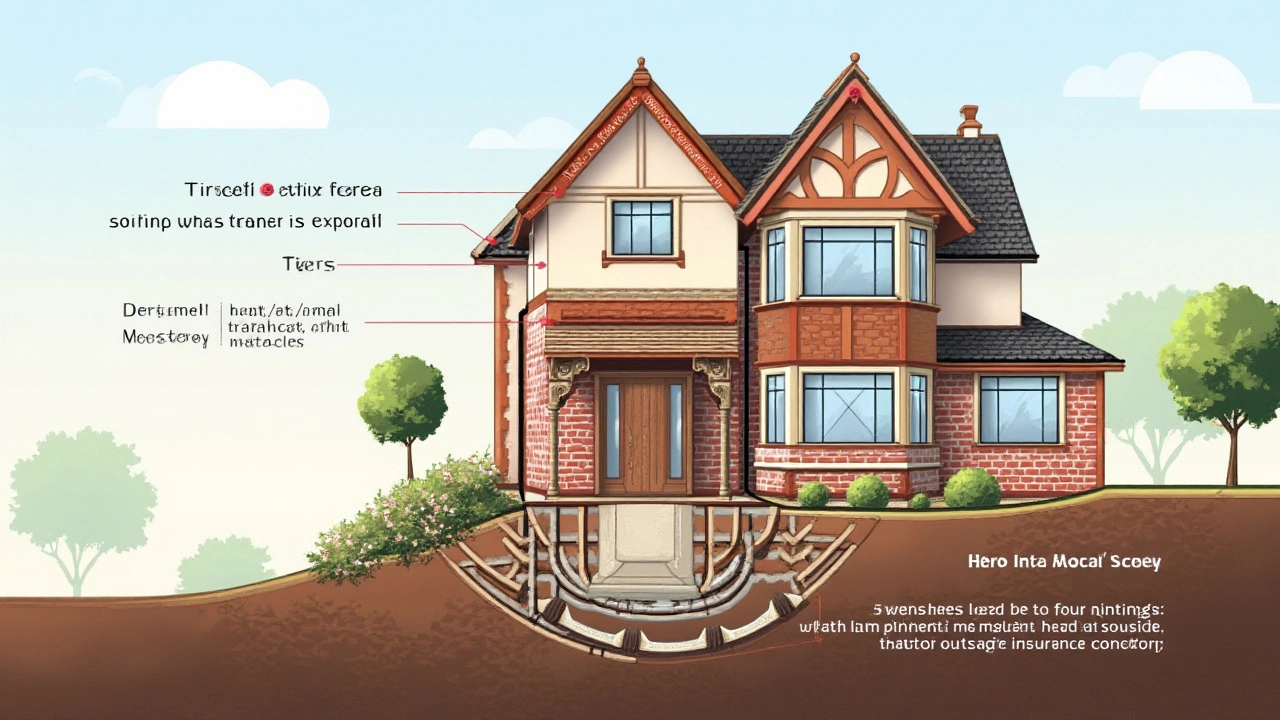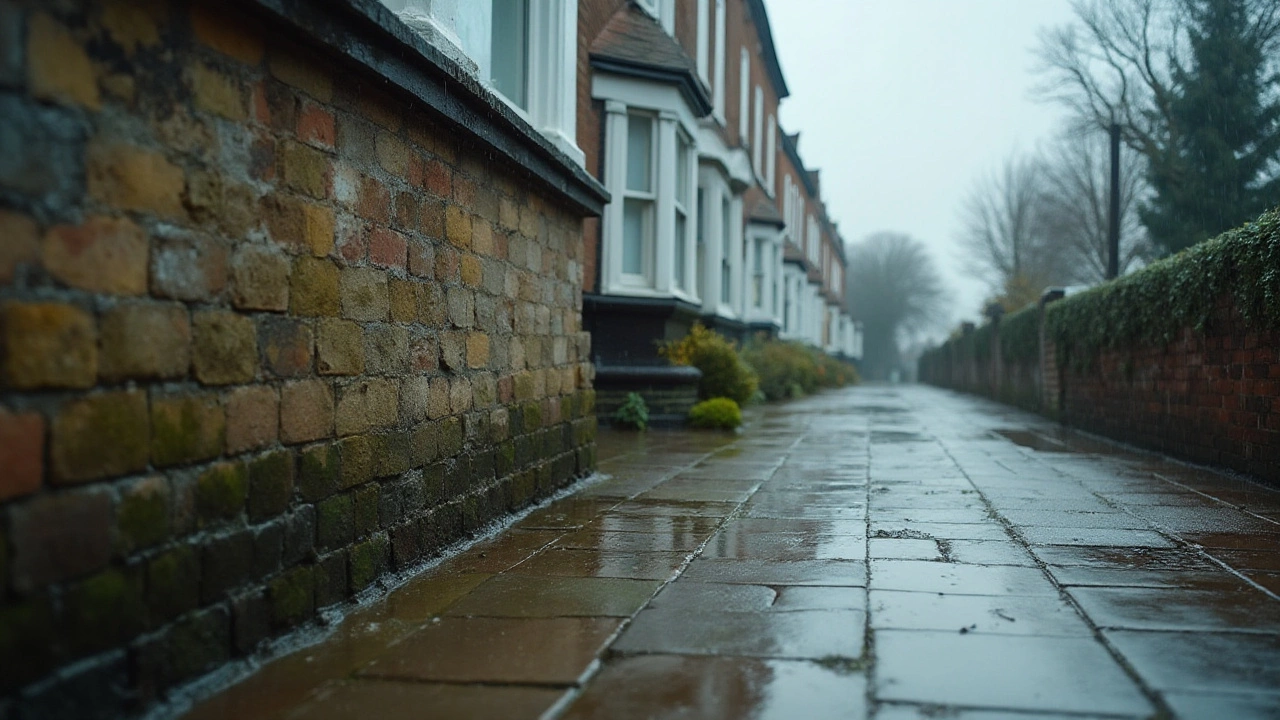Every house stands on a foundation, quite literally the base that supports its structural integrity. Yet, when it comes to insurances, many homeowners are surprised to find that foundation repairs are typically not covered. It's a common inquiry: why isn't such an essential component of a home included in the standard insurance policy?
To unravel this question, it's important to consider the nature of home insurance. These policies are designed to cover unexpected damage from events like fires, storms, or theft. However, foundation issues often arise from long-term wear and tear, ground shifting, or lack of maintenance, which fall outside the umbrella of sudden damage.
While it might seem unfair at first glance, there are practical steps homeowners can take to protect their homes' foundations. Whether investing in regular inspections or understanding the potential environmental impacts on your property, being proactive can go a long way in keeping unnecessary costs at bay.
- The Role of a House Foundation
- Understanding Home Insurance Policies
- Common Causes of Foundation Problems
- Why Foundations Aren’t Covered
- Preventive Measures for Homeowners
- Alternative Solutions for Coverage
The Role of a House Foundation
At the core of every sturdy home lies its foundation. This essential component is more than just a solid base—it plays a crucial role in maintaining the house's structural stability and safety. A well-constructed foundation evenly distributes the weight of the building, ensuring that all parts support each other effectively. It's designed to bear the loads imposed by the structure above while adapting to the shifts in soil or environmental conditions below. Think of it as the unseen hero of your home, tirelessly working to keep everything in place.
Delving deeper, the foundation is responsible for providing resistance against the elements. For instance, it acts as a barrier to protect the rest of the building from moisture intrusion, which has long-term consequences if ignored. It also offers insulation against cold weather, helping maintain energy efficiency within the home. Notably, a foundation must manage even more than just weight and weather. It deals with the natural movement of the earth itself. The soil beneath a house can change with the seasons, expanding and contracting due to moisture content or temperature. The foundation compensates for these movements, preventing potential damage to the house itself.
The foundation doesn’t merely hold up walls; it prevents subtle shifts that could, over time, wreak havoc on the house's structural integrity. As soil underneath shifts, the foundation adapts, ensuring windows don't jam and doors don’t scrape. This is critical, especially in areas prone to natural events like earthquakes or heavy flooding. One interesting fact is that different regions and climates have diverse types of foundations suited to local conditions, showing the breadth of adaptation needed in construction.
Understanding the importance of the foundation can’t be overstated. Architects and engineers invest considerable time in its design and placement, often considering the surrounding environment. In Steven Winter's insightful architectural analysis, he notes,
"A foundation is not just an element of the building but a communion with the earth beneath it, forming a partnership that ensures resilience and endurance over decades."This intimate relationship between the earth and the man-made structure stands testament to careful planning and execution at every phase.
Moreover, it’s essential to recognize the signs of potential foundation troubles early on. Cracks in walls, uneven floors, or misaligned doors should prompt immediate inspection. Identifying issues promptly can save a homeowner significant distress and expense. Regular checks and maintenance further emphasize the preventative measures individuals can take to ensure the longevity of their home's foundation. Owners should also familiarize themselves with these subtle signs to act timely in averting bigger issues.
Understanding Home Insurance Policies
Home insurance is a protective shield many rely on, thinking it covers a wide variety of household issues. Yet, not every issue comes under its wing, especially when it comes to foundation repair. A typical home insurance policy is designed to shield homeowners from unforeseen damages usually caused by specific acts of nature or unexpected mishaps. Think of it as a safety net for sudden emergencies like fires, theft, or some forms of water damage. However, when foundation problems creep in over time due to natural settling or wear and tear, these often fall outside the scope of what's covered. Many insurers view foundation-related issues as maintenance tasks, which are the homeowner's responsibility.
Insurance jargon can often be overwhelming, so it's crucial to dive deeper into what's actually written in your policy. Policies clearly outline 'covered perils' — incidents they'd cover, like a tree falling on your house due to a storm. Sadly, the slow sinking of a foundation typically isn't one of these perils. When delving into the details, you'll spot that foundations might not be covered unless certain specific events, like earthquakes or floods, lead to the damage, and only if you have purchased separate riders for those events. Without these riders, the slow and gradual problems linked to soil erosion or improper drainage usually don't make the cut. In essence, the focus of home insurance is on sudden and accidental events, and foundations, due to the nature of their issues, often don't fit into that category.
To grasp these exclusions, it's beneficial to listen to perspectives from those who've experienced the surprises firsthand.
"Many policyholders only realize the gaps in their coverage when faced with an unexpected repair bill," shares Susan Lomax, an industry expert. "Understanding these nuances can save homeowners from financial strain."Beyond reading the fine print, it's vital to communicate transparently with your insurer. Before facing frustrations, it's wise for homeowners to schedule a conversation with their agent. Ask specific questions about what's covered if foundation issues arise. This proactive approach ensures you're equipped with knowledge and can consider supplementary options like adding specific endorsements to your policy. Remember, knowledge is the best tool you have to bridge those sneaky coverage gaps.
The market's landscape isn't static; it's constantly evolving as insurers respond to shifting risks and consumer demands. Sometimes, this change opens doors for more comprehensive coverage options. Therefore, keeping an eye on new insurance products could pay off. Without the traditional insurance coverage for foundation repairs, many homeowners might end up paying out of pocket. Engaging in regular policy reviews and thorough home maintenance is beneficial. A keen understanding of how your home insurance policy operates can be a defining factor in safeguarding your finances when unexpected foundation issues arise. After all, peace of mind starts with knowing where your coverage ends and your own diligence begins.

Common Causes of Foundation Problems
Foundations are the backbone of every home, and when they start to fail, it can spell serious trouble for the entire structure. The causes of foundation issues are myriad and varied, each with its own set of challenges to overcome. One of the most prevalent culprits is soil. Soil composition, expansion, and contraction play a critical role in the health of a home's foundation. As the seasons change, certain types of soil—like clay—can swell significantly with moisture or shrink just as much during drought. This constant movement creates pressure against the foundation, leading to cracks and shifts that are costly to repair.
Another major factor influencing foundation stability is poor drainage around the home. When water consistently accumulates around the foundation, it can lead to erosion, weakening the soil that supports the house. A well-planned drainage system is key to diverting water away from the foundation and reducing hydrostatic pressure. Homeowners often overlook the potency of water until puddles appear in basements or doors and windows don't close properly anymore. Alongside drainage issues, improper grading during construction can also cause water to pool around the foundation, accelerating wear and tear.
Natural disasters should not be underestimated either. Earthquakes pose an obvious threat to foundations, but even smaller incidents like minor ground tremors can cause damage over time. Similarly, regions prone to frequent flooding, hurricanes, or severe thunderstorms face increased risk as excess water and ground saturation compromise the integrity of the foundation. Interestingly, one study found that regions experiencing weather extremes, alternating between very wet and very dry seasons, have the highest percentage of foundation damage repairs annually. Those living in such areas must pay extra attention to their home's structural health.
Yet another threat is the encroachment of large trees growing close to the house. Their roots, searching for water, can extend far, sometimes even under foundations if the conditions are right. This can lead to soil displacement or can undermine moisture content in the ground, contributing to foundation settling or cracking. Bringing in professional landscaping advice or tree removal can prevent these issues before they ever take root.
As one industry expert famously cautioned, "Foundations are the heart of the home; treat them with the same care and preparation."Proper prevention and timely intervention can go a long way in avoiding major foundation repairs and the headaches that accompany them.
Why Foundations Aren’t Covered
When examining why home insurance doesn't usually cover foundation repair, it boils down to the nature of insurance itself. Insurance is fundamentally designed to guard against unforeseen events, providing financial support in instances of accidents or emergencies. It thrives on the unpredictability of events, those sudden and often catastrophic incidents that can cause significant damage. A tree falling on your roof? Covered. Burglary? Absolutely. A naturally occurring event, such as a tornado decimating the structure of your home? You bet. However, foundation problems often develop gradually over time, resulting from predictable and inevitable elements such as environmental shifts, natural settling, or absent maintenance. These foundation issues generally don't stem from acute and immediate hazards, making them a difficult candidate for coverage.
Since insurance companies base their judgments on likelihood and risk factors, the notion that your house might settle some as a natural progression doesn't tick the boxes for immediate risk. They see the symptoms of poor drainage or soil erosion, over time, as manageable issues that require diligence from the homeowner, akin to changing a car's oil or fixing a leak. In essence, they categorize foundation challenges like routine maintenance—an expected responsibility of homeownership. "Insurance isn't a catch-all safety net for normal degradation," an expert at the National Association of Insurance Commissioners once explained. This perspective shifts the onus of foundation upkeep directly onto the homeowner.
Another reason house foundations aren't commonly covered revolves around the complex liability such claims could incur. Imagine thousands of claims from homeowners witnessing cracks or shifts in their foundations. Such claims would not only be hard to manage but also entail massive costs for insurers that aren't anticipated. The sheer possibility of it could trigger price hikes for policies across the board. Consequently, insurance providers steer clear of this risk, categorically excluding it. Nevertheless, that doesn't mean homeowners aren't without options. Some might consider additional insurance riders or specific policies aimed at foundation repair, although availability and necessity will vary based on individual circumstances and geographic location.

Preventive Measures for Homeowners
Maintaining a strong and stable foundation is crucial for any home. To avoid the headache of unexpected foundation repair costs, it's wise for homeowners to incorporate preventive measures into their routine home maintenance. The first step is to understand that moisture control is key. Too much water around the house can lead to soil expansion, which puts pressure on the foundation walls, while too little can cause the soil to shrink, leading to settling issues. One preventive measure is to ensure proper grading around the house so that water flows away from the foundation, not towards it. Gutters and downspouts should be regularly checked and cleaned to direct rainwater effectively.
Another essential factor to consider is tree placement. Trees and shrubs planted too close to the house can have roots that interfere with the house foundations. These roots can exacerbate settlement as they search for water. As a rule of thumb, trees should be planted at least as far away from the house as their mature height. Regular tree maintenance and thoughtful landscaping can mitigate this issue. In addition, routine inspections by professionals specializing in foundation health are highly advisable. Detecting potential problems early can save homeowners substantial money and effort in the long run.
According to the International Association of Certified Home Inspectors, "Preventive maintenance is essential to preserve the value and safety of your home."
Temperature changes can also impact foundation stability. During extreme heat, watering the foundation carefully can prevent the soil from drying out too severely. Similarly, during frigid temperatures, ensuring proper insulation and sealing could prevent frost heave, which can be equally damaging. Another approach is to invest in waterproofing systems, which act as a barrier against moisture intrusion. These can be installed during construction or added to existing homes.
Homeowners should use these strategies to keep their dwelling sound and avoid unforeseen expenses. Maintaining an insurance coverage policy specifically for foundation concerns is often not an option, so understanding and employing these preventive measures becomes even more valuable. While no method guarantees the avoidance of all issues, these steps can significantly reduce the risk, enhancing the longevity and safety of the home for years to come.
Alternative Solutions for Coverage
When it comes to addressing foundation repair, many homeowners find themselves unsettled by the lack of insurance coverage. Fortunately, there are alternative solutions that can help mitigate the financial burden of unexpected repairs. One viable approach is to investigate a specialized home warranty or maintenance plan. These are distinct from traditional insurance policies and can sometimes offer limited coverage for specific types of foundation issues, providing a buffer against unexpected expenses. Home warranties typically cover the repair or replacement of home systems and appliances, and some companies offer plans that include the home’s foundation amongst their list of supported features.
It's crucial to carefully examine these plans, as they vary greatly in terms of what they provide. Not all home warranties automatically cover foundations, and those that do may come with considerable exclusions. Reading the fine print and asking specific questions about coverage limits and deductibles can save you from potential surprises down the line. Another thoughtful move is to engage in regular preventive maintenance. While it might not sound like an alternative to actual coverage, maintaining your home in excellent condition is one of the surest and most proactive ways to avoid major expenses. Early detection of cracks, water pooling, and soil erosion around the foundation can prevent costly repairs later on.
"An ounce of prevention is worth a pound of cure," observes the National Association of Home Builders, emphasizing the importance of consistent upkeep.Nevertheless, foundation repair costs might still arise, and for such cases, a separate savings account or a home improvement line of credit could be indispensable. Homeowners who allocate a portion of their savings specifically for home maintenance are more prepared to handle costs when they do occur. Consider implementing a personal savings plan tailored to ensuring that funds are available should the need for emergency repairs arise.
Utilizing Personal Savings and Credit
Having direct access to funds via savings or credit lines offers peace of mind and financial flexibility. Establishing a home equity line of credit (HELOC) can become a lifesaver when unexpected repairs pop up. HELOCs typically have lower interest rates compared to personal loans or credit cards and can provide the funds necessary to cover foundation repair costs promptly. Moreover, HELOCs are often tax-deductible, breaking down some of the financial hurdles homeowners face. Alternatively, homeowners can consider personal loans designed specifically for home improvement projects. The interest rate may differ based on credit scores and lender terms, so it’s important to shop around for the best deal.Taking the time to explore these alternative solutions ensures homeowners aren't left scrambling when faced with the reality of repair costs. These methods of finding financial relief reflect the importance of planning and proactive behavior when thinking about the long-term health and safety of a home.
